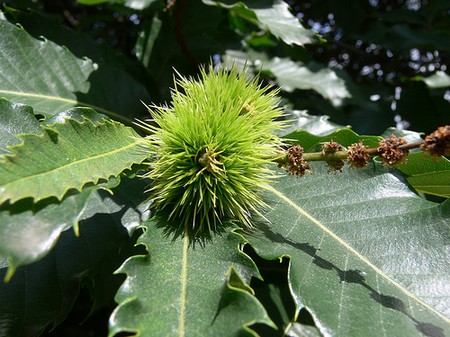The handsome chestnut tree flourishes all over Europe, but is apparently native to Sardis in Asia Minor, from where it gets its name Sardian nut. It was introduced to Britain by the Romans. Evelyn loved chestnut trees and was said to be responsible for planting many stately avenues of them. He described the chestnuts as ‘delicacies for princes and a lusty and masculine food for rusticks, and able to make a woman well-complexioned’.
Sweet chestnuts were known to the Ancient Greeks as Dios balanos (Zeus’ acorns) and dedicated to Zeus. The name Castanea comes from a town called Castanis on Thessaly, an area where chestnut trees were grown in abundance. In Christianity the sweet chestnut tree is a symbol of virtue, chastity and victory over temptation because of the prickly case that encloses the nut.
Chestnuts contain more starch and less oil than other nuts and make a good flour much like a grain flour which can be made into bread. Roast chestnuts and chestnut stuffing are old winter favourites which are highly nutritious, rich in minerals including calcium, magnesium, phosphorus and iron, and easily digestible. Chestnuts used to be fed to loved ones as an enchanting love spell. Marrones are a large sort of sweet chestnut grown in France, Italy and Switzerland, famous for the delicious sweet preserves called matrons glacis.
Herbal remedy
The leaves of the sweet chestnut have an antispasmodic action used for relaxing spasm particularly in the chest which causes paroxysmal coughing in whooping cough and other irritating convulsive coughs. They also act as a febrifuge, useful for bringing down fevers and were used in the past to treat ‘ague’ (malaria). The leaves act to soothe and astringe the mucous membranes throughout the body, and have been used in remedies for catarrh, diarrhoea and bleeding. In Culpeper’s day, chestnut leaves were used to stop bleeding and coughing up blood and to alleviate heavy menstrual bleeding.
The nuts are strengthening and act as a tonic to the nervous system. They are good to eat in the winter, especially by people who feel cold and weak, and who are involved in physical work.
Homeopathic remedy: Castanea vesca
Castanea vesca is prepared from the leaves and is used for whooping cough, in the early stages when the cough is dry, violent and spasmodic. It is also given for diarrhoea accompanied by severe abdominal pain and rumbling which is relieved by a bowel movement.
The flower essence
Sweet chestnut is the remedy for those who feel so stressed, even tortured, that they have reached the limits of their endurance and feel in a state of utter despair. The mind and the body are completely exhausted from uncomplainingly fighting difficulties, cither mental or physical, until a sense of hopelessness and complete darkness sets in. In this ‘dark night of the soul’ sufferers may come face to face with themselves and this may prove the catalyst for entering a new stage in life.
The intensity of suffering may push us on to the threshold of inner transformation, and to another level of consciousness. Sweet chestnut helps during such crises in our lives; it enhances the process of transformation that is possible in such a state of despair and helps to prevent us from simply going to pieces and deriving little or no benefit from the experience.

